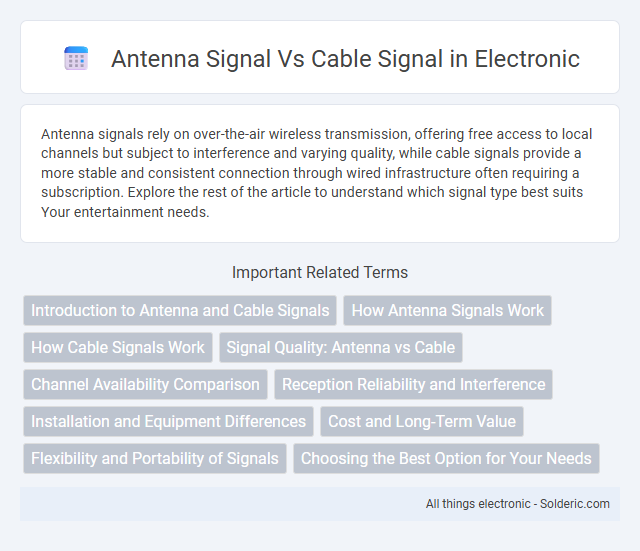Antenna signals rely on over-the-air wireless transmission, offering free access to local channels but subject to interference and varying quality, while cable signals provide a more stable and consistent connection through wired infrastructure often requiring a subscription. Explore the rest of the article to understand which signal type best suits Your entertainment needs.
Comparison Table
| Feature | Antenna Signal | Cable Signal |
|---|---|---|
| Source | Broadcast over airwaves | Delivered via coaxial or fiber optic cables |
| Signal Type | Free-to-air digital or analog | Subscription-based digital or analog |
| Cost | Usually free | Monthly subscription fees apply |
| Channel Availability | Limited local and major networks | Extensive channel lineup including premium |
| Signal Quality | Subject to weather and distance interference | Stable, less interference, consistent quality |
| Installation | Simple antenna setup | Professional installation often required |
| Flexibility | Portable, no contract | Fixed location, contract-based |
| Internet & Additional Services | Not typically included | Often bundled with internet and phone |
Introduction to Antenna and Cable Signals
Antenna signals are broadcasted wirelessly through the airwaves, capturing local over-the-air channels with an antenna receiver, while cable signals are transmitted via physical coaxial or fiber-optic cables directly to your television. Antenna signals often provide free access to local networks but may be affected by distance, obstacles, and weather conditions. Cable signals offer a more stable and consistent transmission with a broader range of channels and premium content, typically requiring a subscription service.
How Antenna Signals Work
Antenna signals work by capturing electromagnetic waves transmitted over the air from broadcast towers and converting them into electrical signals your television can decode. Unlike cable signals, which are delivered through physical coaxial or fiber-optic lines, antenna signals rely on unobstructed line-of-sight and atmospheric conditions for optimal reception. Understanding this process helps you optimize antenna placement to achieve the strongest possible signal and improve picture quality.
How Cable Signals Work
Cable signals work through a network of coaxial or fiber-optic cables transmitting radio frequency (RF) signals directly to your home, ensuring consistent and stable reception unaffected by weather conditions. These signals are typically encrypted and distributed by cable providers, offering a wide range of channels with high-quality audio and video clarity. The wired connection minimizes interference, providing reliable service compared to antenna signals that depend on over-the-air broadcast reception.
Signal Quality: Antenna vs Cable
Antenna signal quality depends on factors like location, weather, and interference, which can cause fluctuations and occasional signal loss. Cable signals typically offer more stable and consistent quality due to a controlled, wired connection with less susceptibility to external disruptions. You can expect cable to provide clearer picture and sound quality, especially in areas with weak over-the-air reception.
Channel Availability Comparison
Antenna signals provide access to a broad range of local broadcast channels free of charge, often including major networks like ABC, CBS, NBC, and FOX, depending on geographic location and signal strength. Cable signals typically offer a much larger channel lineup, including premium channels, niche networks, and on-demand content, but require a subscription fee. Channel availability varies widely with antennas based on distance from broadcast towers, while cable ensures consistent access to a fixed package of channels regardless of location.
Reception Reliability and Interference
Antenna signals rely on over-the-air transmission, making reception reliability subject to weather, physical obstructions, and distance from broadcast towers, which can cause signal dropouts or fluctuations. Cable signals, transmitted through wired connections, offer more consistent and stable reception with minimal interference from environmental factors. Your choice between antenna and cable impacts the quality and reliability of your viewing experience, especially in areas prone to signal disruption.
Installation and Equipment Differences
Antenna signal installation requires an outdoor or indoor antenna, a coaxial cable, and often a signal amplifier to capture over-the-air broadcasts, making the setup relatively simple and cost-effective. Cable signal installation involves connecting to a service provider's network through a cable box or modem, requiring professional setup or activation of equipment such as a digital converter or DVR. Antenna setups provide free access to local channels without monthly fees, while cable installations typically include subscription costs and may require renting or purchasing additional hardware.
Cost and Long-Term Value
Antenna signals offer a low-cost option with free access to local channels, eliminating monthly fees and making them ideal for budget-conscious consumers seeking long-term savings. Cable signals require ongoing subscription fees that can accumulate significantly over time, impacting overall cost-effectiveness despite providing a broader range of channels. Investing in an antenna yields durable equipment with minimal maintenance costs, enhancing long-term value compared to fluctuating cable service expenses.
Flexibility and Portability of Signals
Antenna signals offer greater flexibility and portability compared to cable signals, as they do not require physical connections and can be accessed anywhere within the broadcast range. Your device can easily switch between different channels and locations without being tethered to a fixed cable infrastructure. Cable signals, on the other hand, depend on a stationary wired setup, limiting mobility and the ability to receive signals outside designated service areas.
Choosing the Best Option for Your Needs
Antenna signals provide free over-the-air access to local channels with high-definition quality, ideal for cord-cutters seeking cost-effective viewing. Cable signals offer a broader range of channels and reliable service with consistent quality, suitable for users needing extensive programming and bundled services. Assess your channel preferences, budget, and desired signal reliability to determine the best option for your entertainment needs.
antenna signal vs cable signal Infographic

 solderic.com
solderic.com